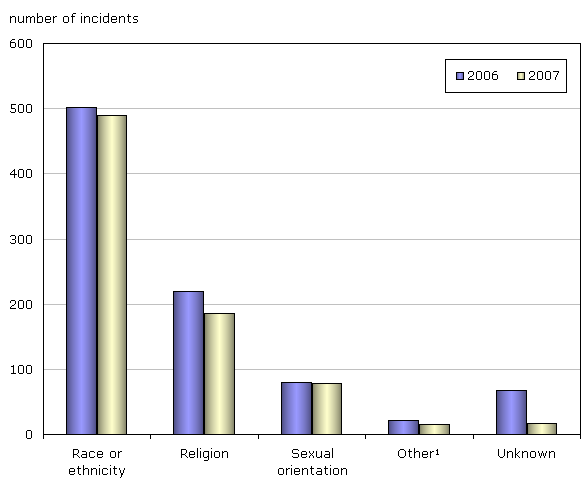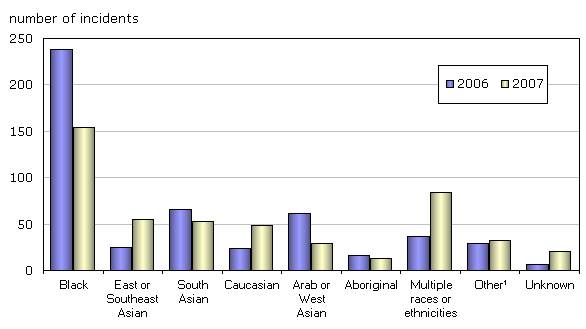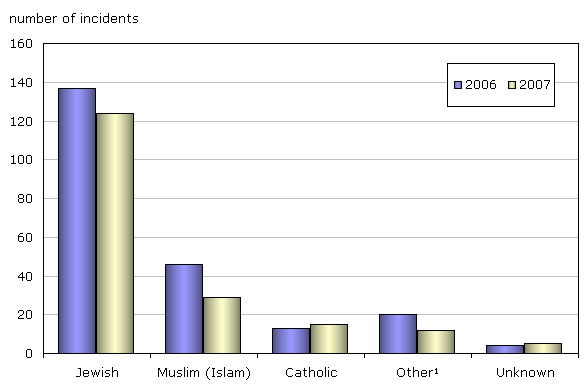Police-reported hate crime in Canada, 2007
Archived Content
Information identified as archived is provided for reference, research or recordkeeping purposes. It is not subject to the Government of Canada Web Standards and has not been altered or updated since it was archived. Please "contact us" to request a format other than those available.
By: Philip Walsh and Mia Dauvergne
Police services report fewer hate crimes in 2007 than in 2006
Highest rate of hate crime reported in Calgary for second year
Mischief most common type of hate crime
Racial biases most common motivation for hate crime
Blacks remain most commonly targeted racial group despite fewer incidents
Hate crimes against Jewish and Muslim faiths decline
Youth account for one-third of those accused of hate crimes
Summary
Source
References
Detailed data tables
Notes
Canada's population is becoming increasingly diverse as its racial, cultural, religious, linguistic and demographic compositions continue to change. According to the 2006 Census, Canada's visible minority population grew 27% from 2001, five times faster than the population as a whole (Statistics Canada, 2008). The number of same-sex couples also increased, up by 33% over the same period (Statistics Canada, 2007). The religious composition of the country is also changing, with some of the largest increases between 1991 and 2001 seen in Muslim, Hindu, Sikh and Buddhist denominations (Statistics Canada, 2003).1
Some research has identified demographic change as a risk factor for the development of hate attitudes and crimes (Shaw and Barchechat, 2002). Hate crimes refer to criminal offences that are motivated by hatred towards an identifiable group. The incident may target race, national or ethnic origin, language, colour, religion, sex, age, mental or physical disability, sexual orientation or other factors, such as occupation or political beliefs. Hate crimes are distinct from other types of crime as their impact can have resounding effects, not only upon victims, but also on their respective communities and on Canadian society itself (OSCE, 2005).
In Canada, the crimes of advocating genocide, public incitement of hatred and mischief in relation to religious property have been incorporated into the Criminal Code as distinct hate crime offences. In addition, sentencing provisions allow for increased penalties when hate is determined to be an aggravating circumstance in any criminal offence. According to a recent international hate crime survey, over 30 member-countries of the Organization for Security and Cooperation in Europe have adopted legislation intended to address crimes motivated by hatred (Stahnke et al., 2008).
There are two data sources that can be used to measure hate crime in Canada. One is the Uniform Crime Reporting (UCR) Survey which collects hate crime data from police services and the other is the General Social Survey (GSS) which collects data from Canadians who report having been victimized by a hate crime. Both surveys show the proportion of all crime motivated by hate to be relatively low, although the number of hate crimes reported by GSS respondents is considerably higher than that reported by police services.2
The present Juristat article3 analyses 2007 data on the nature and extent of hate-motivated crimes that have been reported to, and substantiated by, Canadian police services covering 87% of the population.4 These same police services reported hate crime data in 2006 enabling, for the first time, comparisons to be made between two survey years.
The number of hate crimes reported by police services likely represents an under-count of the true incidence of this type of offence. Findings from the GSS, last conducted in 2004, indicate that only about 40% of hate crimes had been reported to police.5 A victim's decision of whether or not to report an incident may be influenced by the presence of specialized hate crime units, zero tolerance programs, victim assistance programs, hot-lines and community awareness campaigns offered by some police services. Victims may also weigh the importance of the incident, the sensitivity of the issue and whether they believe police could help.
Police services report fewer hate crimes in 2007 than in 2006
Near-national data on the incidence of police-reported hate crime were first available in Canada in 2006. In that year, police services covering 87% of the population identified 892 incidents that had been motivated by hate, representing a rate of 3.1 per 100,000 population. In 2007, these same police services reported 785 incidents, resulting in a rate of 2.7 per 100,000 population, 13% lower than the previous year.
Hate crimes continued to account for a relatively low proportion of all police-reported crimes. In 2007, 0.04% of all crimes were determined by police to have been motivated by hate.
Highest rate of hate crime reported in Calgary for second year
Due to limited coverage in many provinces and territories, provincial analysis of hate crime is possible only for Quebec, Ontario and British Columbia.6 Together, these three provinces accounted for about 8 in 10 hate-motivated incidents reported by police.
Between 2006 and 2007, declines were reported in Quebec and Ontario, down by 36% and 14%, respectively. Police-reported hate crimes in British Columbia remained relatively stable (Text Table 1).
| Provinces | 2006 | 2007 | ||
|---|---|---|---|---|
| number | rate | number | rate | |
| Quebec | 104 | 1.4 | 67 | 0.9 |
| Ontario | 520 | 4.1 | 453 | 3.6 |
| British Columbia | 107 | 2.5 | 104 | 2.4 |
| Source: Statistics Canada, Canadian Centre for Justice Statistics, Uniform Crime Reporting Survey. | ||||
The overall decrease in police-reported hate crimes, as well as the provincial declines in Quebec and Ontario, were largely the result of fewer incidents reported in Canada's two largest census metropolitan areas (CMAs),7Montréal (-43) and Toronto (-19) (Table 1). The number of incidents reported by police services in non-census metropolitan areas, including small cities, towns and rural areas, also declined, down by a total of 60 incidents. These decreases were offset somewhat by increases reported in several other large urban centres, namely, Edmonton (+17) and Hamilton (+13).
Despite having 9 fewer incidents in 2007 than in 2006, Calgary reported the highest rate in the country for the second consecutive year (Chart 1). The CMAs of Saguenay and Sherbrooke did not report any hate-motivated incidents in 2007, as was the case in 2006.
The rate of police-reported hate crime in a given area can be influenced by citizens' willingness to report incidents to their local police service. The relatively high rate in Calgary, for instance, may be partially due to an initiative launched in 2001 by the Calgary Police Service in which one of the main objectives is to encourage people to report hate crimes.8 The increase in Hamilton may be the result of outreach work by police with community groups that began in 2006.9 In other words, what may appear to be a higher incidence of hate-motivated crime in a given area, may be a reflection of differing police service initiatives.
Chart 1
Hate crimes reported by police, by census metropolitan area, 2007

1. Excludes the proportion of crime from the Halton Regional Police Service and Durham Regional Police Service that falls into the Toronto and Hamilton CMA boundaries.
Source: Statistics Canada, Canadian Centre for Justice Statistics, Uniform Crime Reporting Survey.
Mischief most common type of hate crime
In both 2006 and 2007, police categorized about 7 in 10 hate crimes as non-violent. The proportions were the same each year despite the fact that, in 2007, hate crime data were based upon a smaller subset of police services covering 22% of the population of Canada.10
By far the most common type of hate crime was mischief, including acts of graffiti or vandalism of public property, accounting for roughly half of all incidents each year. Minor assaults (14%) and uttering threats (8%), in which little to no physical harm was caused to the victim, were the most common types of violent hate crime offences. There was one homicide motivated by hate in 2007. Since 1991, there have been a total of 23 hate-motivated homicides or about one incident per year.11
Racial biases most common motivation for hate crime
Police-reported data from both 2006 and 2007 show that, in Canada, there are three primary motivations for hate crimes: race or ethnicity, religion and sexual orientation (Table 2 and Chart 2). Among incidents where the motivation was known to police, the most common was race or ethnicity, accounting for about 6 in 10 incidents each year. The most recent self-reported victimization data from 2004 also show race to be the most commonly cited motivation for hate crime (66%) (Dauvergne, Scrim and Brennan, 2007), as do comparable 2007 hate crime data from the United States (51%)12 and Sweden (70%) (McClintock and LeGendre, 2008).
Religious motivations accounted for another 24% of hate crimes in 2007 and sexual orientation, predominantly homosexuality, for 10%. The remaining 2% of incidents were motivated by a variety of factors, such as mental or physical disability, sex, language, occupation and political beliefs. These proportions were all very similar to those reported by police in 2006.
Chart 2
Hate crimes reported by police, by type of motivation, 2006 and 2007

1. Includes all other motivations not otherwise stated (e.g. mental or physical disability, gender, language, occupation and political beliefs).
Source: Statistics Canada, Canadian Centre for Justice Statistics, Uniform Crime Reporting Survey.
Blacks remain most commonly targeted racial group despite fewer incidents
While the primary motivations for hate crime remained consistent from 2006 to 2007, there was some variation within these categories. Among racially-motivated incidents identified by police, the number of hate crimes that targeted Blacks fell from 238 in 2006 to 154 in 2007 (Chart 3). That being said, Blacks continued to represent the most commonly targeted racial group, accounting for one-third of all racially-motivated hate crimes.
The number of incidents against Arab or West Asian groups (including Egyptians, Iranians, Iraqis and Lebanese people) and South Asians (East Indian and Pakistanis) also decreased from the previous year. In contrast, hate crime incidents that targeted East or Southeast Asian groups (including Chinese, Japanese, Vietnamese) and Caucasians both increased. Hate crimes directed at multiple racial groups also increased.
Chart 3
Racially-motivated hate crimes reported by police, by type of race, 2006 and 2007

1. Includes all other hate crimes in which the type of race or ethnicity is not otherwise stated (e.g. Latin American, South American).
Source: Statistics Canada, Canadian Centre for Justice Statistics, Uniform Crime Reporting Survey.
Hate crimes against Jewish and Muslim faiths decline
There were 185 religiously-motivated incidents in 2007, down from 220 in 2006. The overall decrease was the result of fewer hate crimes committed against both Jewish and Muslim faiths (Chart 4). Despite declining, however, incidents targeting the Jewish faith continued to account for more than two-thirds of all hate crimes motivated by religion.
Chart 4
Religiously-motivated hate crimes reported by police, by type of religion, 2006 and 2007

1. Includes all other religions not otherwise stated (e.g. Sikh, Hindu, Buddhism and Greek Orthodox).
Source: Statistics Canada, Canadian Centre for Justice, Uniform Crime Reporting Survey.
Youth account for one-third of those accused of hate crimes
Information on the characteristics of persons accused of hate-motivated crime in 2007 is available from the subset of police services covering 22% of the population.13 These data indicate that youth (12 to 17 years) accounted for a disproportionate number of accused persons, similar to the finding in 2006. One-third (32%) of persons accused of hate crime in 2007 were youth, almost double the proportion of youth accused of crime in general (17%).
Summary
From 2006 to 2007, the number of police-reported hate crimes in Canada decreased from 892 incidents to 785 incidents. The nature of this offence, however, including both the type of offences and the primary motivations remained fairly consistent. In both years, mischief offences accounted for about half of all incidents and biases against race or ethnicity, religion and sexual orientation were the most common motivations. Calgary reported the highest rate of hate crime in both survey years. The relatively high rate in Calgary may partially reflect a proactive hate crime initiative which encourages citizens to report this type of incident to police.
Source
Uniform Crime Reporting Survey
The incident-based Uniform Crime Reporting (UCR2) Survey is a micro-data survey that captures detailed information on crimes reported to and substantiated by police, including the characteristics of victims, accused persons and incidents. In response to changing information needs, the survey was modified in 2005 (UCR 2.2) to enable the identification of incidents motivated by hate based on race, national or ethnic origin, language, colour, religion, sex, age, mental or physical disability, sexual orientation or any other similar factor (such as occupation or political beliefs). In 2007, police services reporting to the UCR 2.2 Survey covered 22% of the population of Canada.
A supplemental survey was conducted in 2006 and 2007 as a means of obtaining information on hate-motivated crimes from those police services reporting UCR2 data but who had not yet converted their electronic reporting systems to the newer UCR2.2 version. These respondents were asked to identify those criminal incidents that had been motivated by hate and to manually provide the detailed characteristics of each incident to Statistics Canada.
Combined, coverage from the UCR2.2 Survey and the supplemental survey is estimated at 87% of the population of Canada. The RCMP, outside of British Columbia, were unable to provide information. In addition, a small number of police services, still reporting to the old aggregate version of the UCR survey, were also unable to respond.
References
Dauvergne, M., K. Scrim and S. Brennan. 2007. "Hate Crime in Canada, 2006". Canadian Centre for Justice Statistics Profile Series. No. 17. Statistics Canada Catalogue no. 85F0033M.
/pub/85f0033m/85f0033m2008017-eng.htm (accessed March 2, 2009).
McClintock, Michael and Paul Legendre. 2007. Country-by-Country Hate Crime Report Card. Human Rights First. New York.
Organization for Security and Cooperation in Europe (OSCE). 2005. "Combating hate crimes in the OSCE region: An overview of statistics, legislation, and national initiatives". Office for Democratic Institutions and Human Rights. Warsaw, Poland.
Shaw, M. and O. Barchechat. 2002. "Preventing Hate Crimes: International Strategies and Practice". International Centre for the Prevention of Crime.
Stahnke, T., P. LeGendre, I. Grekov, M. McClintock, A. Aronowitz and V. Petti. 2008. 2008 Hate Crime Survey, Human Rights First. New York.
Statistics Canada. 2003. "2001 Census Analysis Series: Religions in Canada." Catalogue no. 96F0030XIE2001015.
http://www12.statcan.gc.ca/english/census01/products/analytic/companion/
rel/contents.cfm (accessed March 2, 2009).
Statistics Canada. 2007. "2006 Census: Families, marital status, households and dwelling characteristics". The Daily. September 12.
/daily-quotidien/070912/dq070912a-eng.htm (accessed March 2, 2009).
Statistics Canada. 2008. "2006 Census: Ethnic origin, visible minorities, place of work and mode of transportation". The Daily. April 2.
/daily-quotidien/080402/dq080402a-eng.htm (accessed March 2, 2009).
Detailed data tables
Table 1 Hate crimes reported by police, by census metropolitan area, 2006 and 2007
Table 2 Hate crimes reported by police, by type of motivation, Canada, 2006 and 2007
Notes
- Based upon data from the 2001 Census, as the 2006 Census did not include questions pertaining to religious denomination.
- For further information on comparisons of police-reported and victim-reported hate crimes, see Dauvergne, M. K. Scrim and S. Brennan. 2007. "Hate Crime in Canada, 2006". Canadian Centre for Justice Statistics Profile Series. No. 17. Statistics Canada Catalogue no. 85F0033M.
- Funding for the collection of police-reported hate crime in 2007 was provided by the Department of Citizenship and Immigration in support of "Canada's Action Plan Against Racism" (CAPAR), a five-year project combining federal government programs and major initiatives to combat racism and promote inclusion in Canada.
- For further information, see "Source" at the end of this report.
- Data collection for the 2009 General Social Survey on Victimization is currently underway and results are expected in 2010.
- In 2006 and 2007, the Royal Canadian Mounted Police (RCMP), who provide policing services to all provinces and territories (except Quebec and Ontario), were unable to report hate crime data outside of British Columbia due to on-going changes in their electronic reporting system.
- A census metropolitan area refers to a large urban core (at least 100,000 population) combined with adjacent urban and rural areas that have a high degree of economic and social integration.
-
See
Calgary Police Service website:
www.calgarypolice.ca/community/hate_bias.html (accessed February 2, 2009). -
See
Hamilton Police Service website "2007 Hate Bias Report":
www.hamiltonpolice.on.ca/NR/rdonlyres/C40EDBA0-0A04-4564- 9AC3-
D8DAEF8013C9/1366/ 08054_YearEnd_HateCrime_2007.pdf (accessed April 17, 2009). - The information contained in this section was reported by 32 municipal police services, 52 RCMP detachments and the Royal Newfoundland Constabulary. Combined, these police services covered 22% of the population of Canada.
- This information was derived from the Homicide Survey which began collecting data on hate-motivated homicides in 1991. The one hate-motivated homicide that occurred in 2007 was not included in the analysis elsewhere in this report as it occurred within the jurisdictional boundaries of a police service that was unable to participate in the study.
-
See
Federal Bureau of Investigation website:
http://www.fbi.gov/ucr/hc2007/index.html (accessed March 2, 2009). - See note 10.
- Date modified:
